Early Season Frost Damage to Corn
Crop Insights from Pioneer Agronomy Sciences
Crop Insights from Pioneer Agronomy Sciences
The potential for late spring freeze or frost damage to corn exists on an annual basis throughout much of North America. This Crop Insights examines microclimate differences affecting frost occurrence, describes symptoms of frost damage to corn, and reviews research and experience with factors that may kill frost-damaged plants. Assessing recovery potential and determining post-frost management options are also discussed.
Various symptoms help growers identify when low temperatures have produced frost damage to corn:
Darkening of leaves - Within the first 24 hours after the frost, corn plants will take on a darkened, almost black appearance due to the destruction of cell membranes and the release of cell contents from damaged corn leaves (Figure 1).
Plants turn brown - When plant cells have been destroyed, the damaged leaf portions will dry up and begin to turn brown within a day after a frost. Some lower plant parts (pseudo stem) may remain intact and stay green (Figure 1).
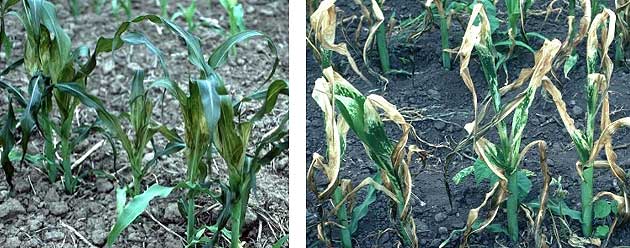
Figure 1. Plants showing darkened leaves within 24 hours of frost injury (left). Injured tissue will become wilted and necrotic (right).
While general climatic systems can bring freezing temperatures to a region, there are other microclimatic factors that may contribute to differences in the potential for frost damage in a field. These factors include the following:
Topography / elevation - In hilly areas, cold, dense air will flow to depressions and valleys causing these areas to be cooler than the surrounding high points (Figure 2).
Soil radiation - Soils radiate heat upward and warm the air immediately above the soil surface. Crop management practices that encourage soil warming help to prevent frost damage from occurring.
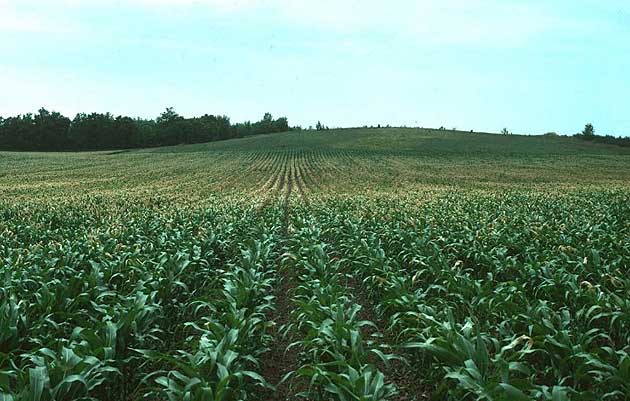
Figure 2. Cold air flows into low areas of hilly fields, resulting in differential crop damage within the field.
Tillage practices - Practices that inhibit soil radiation can increase the probability of frost damage. Tillage systems that leave heavy previous crop residue coverage in a field tend to intercept radiant heat from the soil. This prevents the moderation of nighttime temperatures that often occurs near the soil surface in fields with little or no residue. Without soil heat radiating upward, the young corn leaves are more susceptible to frost damage.
On the other hand, tillage tends to loosen the soil, which decreases soil heat conductance. Tilled soil cannot supply as much radiation heat energy to corn leaves as untilled soil (Bland, 1993). Tillage also tends to dry the soil, which results in lower soil heat capacity. Dry soil near the surface insulates soil below it, which prevents warming of the air above the soil surface by soil radiation. These factors explain why fields that have been cultivated or had anhydrous ammonia applied immediately before the frost often experience more frost damage than adjoining fields.
Soil moisture - Soil moisture can also influence soil radiation potential, with increased heat capacity in wet compared to dry soil. This explains the decreased corn frost injury in fields or portions of fields recently irrigated compared to those that were not irrigated before a frost (Elmore and Doupnik, 1995).
The unique combinations of residue quantity, soil moisture, and soil structure determine corn damage occurrence within specific fields when frost occurs within a region (Tollenaar, personal communication).
Weeds and fencerows - Dense weed patches within fields can have the same influence as previous crop residue on soil radiation. These weedy areas reduce soil radiation and increase the incidence of frost damage. Likewise, vegetation growing in field edges can function as a “blanket” to restrict the ability of warm soil to heat the air above it.
When low temperatures occur in a region and the potential for frost or freeze exists, there are several factors that dictate the extent and severity of frost damage to the corn crop. One of the most important factors is plant maturity. Young corn plants are less susceptible to frost injury that leads to plant death since the growing point is below ground and protected from freezing temperatures. Older plants have more exposed leaves and may have growing points above the soil surface beginning at the six-leaf collar stage (about 12 inches tall). When the large leaves of these corn plants are frozen, they can form a tightly twisted whorl that is difficult for the emerging leaves to penetrate.
Another factor that determines post-frost plant recovery potential is plant health just prior to frost. If plants have been under stress due to cold temperatures, herbicide injury, excessive moisture or disease, they are less able to recover from even minor frost damage. Likewise, when growing conditions following a frost event are not ideal, corn plants may be slow to recover and more susceptible to death.
While often used synonymously, the terms freeze and frost are not completely interchangeable. A freeze is defined as the occurrence of air temperatures below 32 °F or lower measured at five feet above the ground. A frost occurs when the temperature of the earth’s surface or objects on the earth’s surface are 32 °F or lower. (Griffiths and Driscoll, 1982). Given these definitions, it is possible for a frost to occur when a freeze does not.
Kunkel and Hollinger (1995) explain this phenomenon as follows:
“Under certain weather conditions, the official minimum air temperature can be several degrees higher than the minimum temperature of the earth’s surface. Under moderate to high winds, the atmosphere near the ground is well mixed and the air temperature is nearly equal to the surface temperature. However, under light winds and clear skies, the air near the ground cools due to infrared radiation and the temperature of tender vegetation near the surface can be several degrees cooler than the official five-foot temperature.”
When freezing temperatures injure corn plants in a field, some plants may survive and recover, while other plants will die. Corn plants die immediately when growing point tissue is frozen. Corn plants not killed immediately may still succumb to various physical or biological factors that prevent recovery, including:
Plant starvation - Leaf loss due to frost injury reduces photosynthetic area available to produce carbohydrates for new plant growth and recovery.
Plant disease - Injured plants have reduced levels of resistance to secondary pathogens invading damaged tissues.
One of the first steps in diagnosing frost injury is to check the health of the internal growing point. Plants can be split vertically and the growing point region inspected visually for damage (Nielsen, 1999). This is typically manifested as mushy, discolored tissue at the top of the mesocotyl. If the growing point tissue is obviously damaged, plants will not recover. However, even if the growing point appears healthy immediately after the frost, plants still may die.
Cool weather after the frost can delay visible deterioration of damaged tissue on plants. Those plants not directly killed by the frost can succumb to the other factors described above. Therefore, it is usually best to wait until three to five days after the frost or freeze damage occurred to make an assessment of recovery potential (Nielsen and Christmas, 2001).
Crop damage can appear very severe immediately after the injury, but plants often recover if the growing point is not damaged. Nevertheless, each situation is different and decisions regarding whether to keep existing stands or replant often need to be made over a longer period of time on a field-by-field basis. The next sections describe observations from the extensive experience of Pioneer agronomists in assessing frost damaged corn.
Assessing Recovery Potential - Growing Point Below Ground
Recovery from early season death of above ground tissue depends on:
Stage of growth - Potential for recovery is higher at VE-V2 than for V3-V4 stages because energy reserves still exist in the seed to support growth.
Amount of green tissue remaining - The more green tissue there is for the plant to live on until there is enough re-growth for photosynthesis, the higher the potential for recovery, especially at V3-V4 stages when seed reserves are nearly depleted.
Weather conditions during re-growth - Dry, warm conditions are more favorable than cold and wet weather.
Number of frost events - Plants at this stage will often recover from one episode, but reserves can be depleted with multiple frosts while damaged seedlings are recovering. The probability that plants will not recover or that the stand will contain non-competitive “runts” is increased with repeated frost damage/recovery cycles.
Experience has shown that seedlings with tissue damage within 0.5 inches or less of the growing point will most likely not recover. Even if plants survive, potential to produce competitive plants with acceptable yield potential is compromised. Seedlings less severely damaged, with more than 0.5 inches of healthy tissue above the growing point often will survive and develop into plants with high yield potential. Figure 3 (taken 24-48 hours after damage occurred) shows progression from most to least damage for corn seedlings affected by frost within a field when plants were at V1-V2 stages.
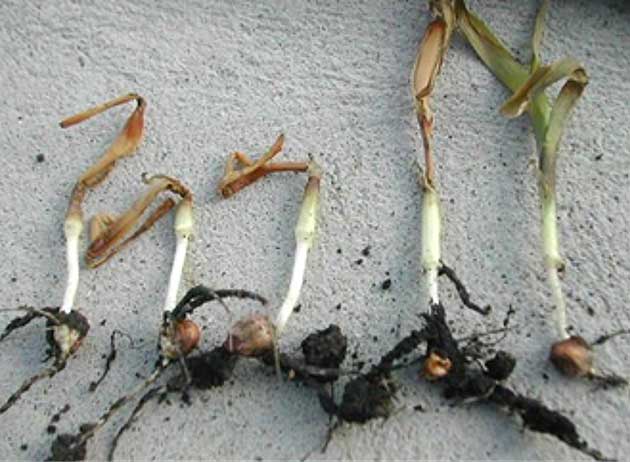
Figure 3. Corn seedlings with a range in damage from frost injury when plants were at V1-V2 stages.
The two seedlings on the left represent those that will likely not recover, even though the growing point was not damaged by the frost. Recovery and yield potential of the seedling in the middle is uncertain. For the seedling second from the right, recovery is likely but three to four days of warm temperatures are needed to verify this. The seedling on the far right has a very high probability of survival with little impact on yield potential. As mentioned previously, in most instances it is best to wait several days before making the final decision regardless of how hopeless or promising seedling damage appears soon after the injury.
After a few days with high temperatures near or above 70 °F, look for green tissue close to the soil surface. If evidence of progressive increases in green tissue are not observed in this portion of the plants, the seedlings are unlikely to recover and produce healthy plants. Fields with visible re-growth should still be monitored for several more days for continued progress. New green plant growth is an important first step but watch for developing leaves and nodal root growth.
Figure 4 to Figure 7 show plants damaged by a frost at the V2 stage, which killed all above-ground leaf tissue to within 0.25 inches of the soil surface.
Two days after the frost, green tissue has emerged, but dead tissue is restricting the new growth. The growing point is a healthy white/yellow color and the mesocotyl is white (Figure 4 and Figure 5).
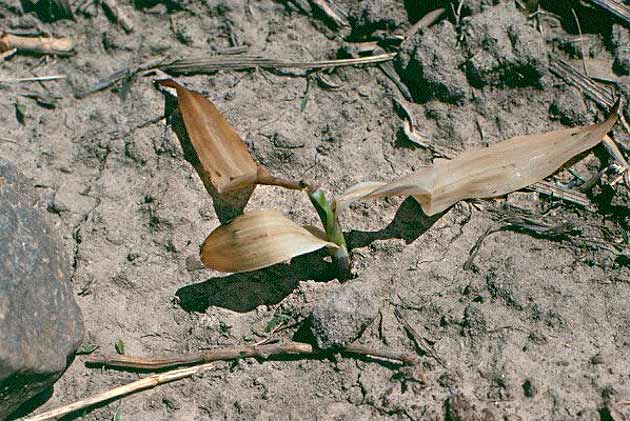
Figure 4. Corn seedling damaged by frost at the V2 stage, two warm days after damage occurred.
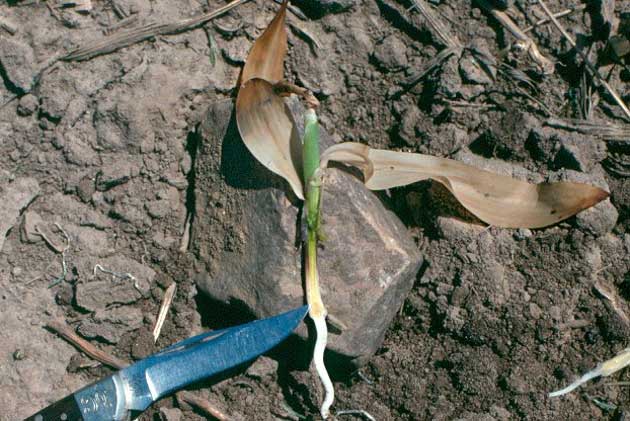
Figure 5. Corn seedling from Figure 4 dissected to show growing point.
Eight days after the frost, plants with this level of damage show significant growth but the two largest leaves are tied at the tip (Figure 6). A small leaf (not visible in the image) is emerging from the whorl, free from the “knot”. This plant is on the way to healthy recovery and should be counted in a post-frost stand assessment. After seven or more days of post-frost warm weather have transpired, any plants that are both smaller than this and still tightly knotted should not be counted in a stand assessment. If conditions are cool after the frost, more than seven consecutive days may be required to develop this level of re-growth.
The plant to the left of the stake in Figure 7 is the same plant as in Figure 6, 20 days after the frost. By this time, the plant has six visible green leaves.
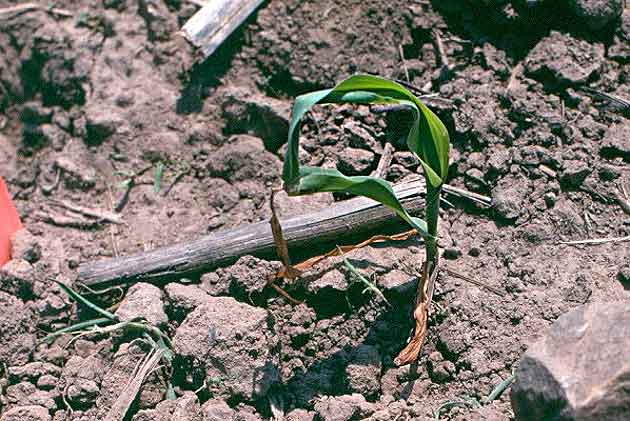
Figure 6. Corn seedling in same field and with similar level of damage as in Figure 4 and Figure 5, eight warm days after damage occurred.
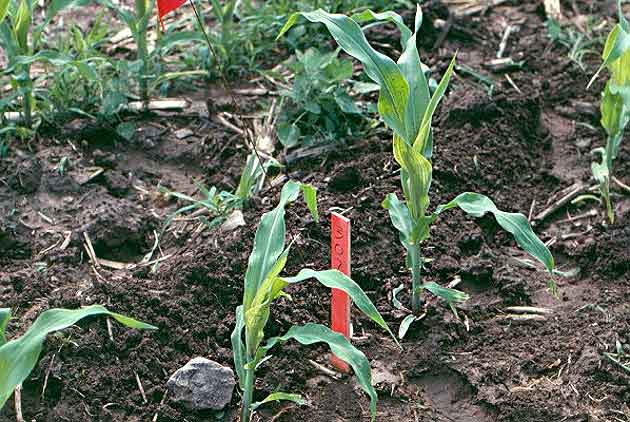
Figure 7. Corn plant left of the stake is same plant as in Figure 6, 20 warm days after damage occurred.
Because of the microclimate factors mentioned above, fields next to each other and plants within fields will respond differently to both the damaging temperatures and the recovery process. When damage has been severe/repeated or if recovery conditions have not been favorable, diligent scouting and close observation for two to three weeks after frost events are often needed before assuming that an accurate, final assessment has been made.
Assessing Recovery Potential – Growing Point Above Ground
Many of the considerations are the same as for earlier stages. It is important to evaluate the health of the growing point and not to assume that plants will recover, even if the growing point was not damaged directly by the frost (Figure 8). Amount of green tissue remaining, growing conditions during re-growth, and whether frost damage involved single or repeated episodes are important factors that will influence recovery potential.
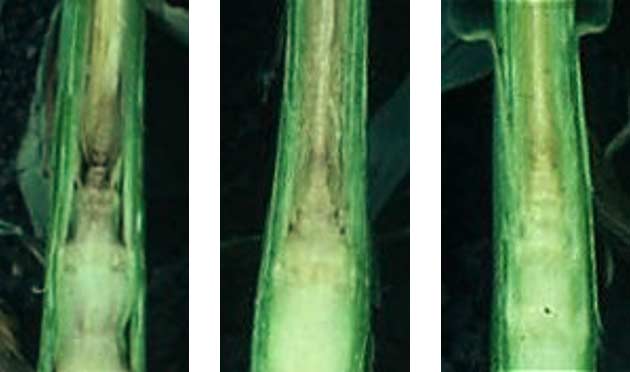
Figure 8. Growing points of dissected corn plants after frost at V5-V6 stage. Left: Growing point is brown indicating plant death. Middle: Growing point is discolored indicating probable death. Right: Growing point is healthy..
Similar to earlier stages, the most reliable way to determine frost impact is to wait until after three to five days with daily high temperatures above 70 °F and check for evidence of new growth. Remove dead whorls and look for erect, lime green leaf growth inside the corn plant. Another sign of active growth is a “rippled” leaf effect within the whorl when the plant is cut lengthwise. The “rippled” leaves indicate that new growth occurring after the frost is backing up behind the damaged, knotted whorl.
After determining the viable stand that remains, growers need to compare yield expectations of the damaged stand versus a late replanted stand and consider replant costs and pest management issues.
Yield expectations of frost-damaged stands can be assessed by measuring stand loss when corn plants are at the six-leaf collar stage or less. Damage effects on yield are relatively minor at these stages for plants that are making progressive recovery. When frost damage occurs to plants beyond the six-leaf collar stage, conservative corn yield loss estimates can be made using hail damage defoliation charts. However, a summary of several Wisconsin studies for corn with 7 to 10 leaf collars indicates that yield losses due to frost damage at these advanced stages can be substantially greater than that suggested in hail damage charts (Figure 9).
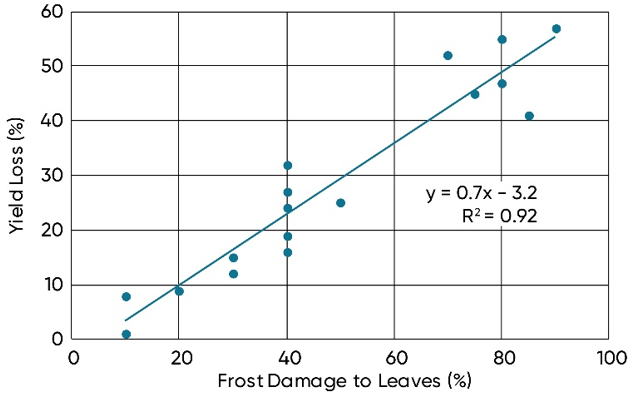
Figure 9. Yield loss for corn when frost damage occurs at the 7 to 10 leaf collar stage of maturity (Carter, 1995).
When growers experience frost damage in a corn field, they are faced with several management options. They may choose to do nothing, leaving the field as it is and allowing plants to recover. Another option if still early in the growing season is to replant the field to corn or another crop. A final management choice is to clip corn plants after frost to remove the dead and decaying tissue found above the growing point (Figure 10 and Figure 11). This is usually only an option when the plants are at the V5 to V6 or later stages when the damage occurs. It will be difficult to clip smaller plants with field-sized clipping equipment.
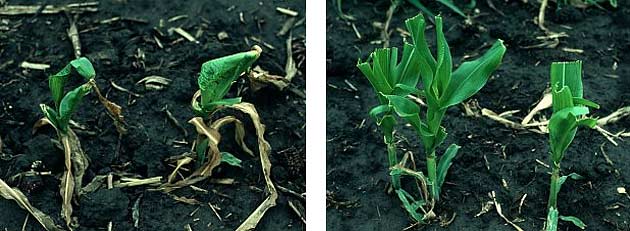
Figure 10. Frost-damaged corn plants two weeks after frost. Plants not clipped (left) and clipped 3 days after the frost (right).
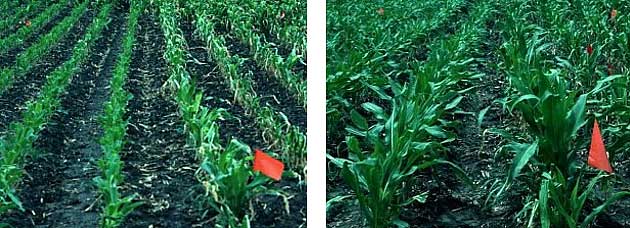
Figure 11. Clipped treatment left of red flag, unclipped treatment at flag. Clipped plants appear less restricted two weeks after the clipping treatment (left). However, very little difference between treatments is apparent one week later (right).
Clipping frozen corn plants to remove dead tissue has been studied by several researchers. While results are somewhat variable, the general conclusion is that clipping does not enhance yield in most situations, and often further reduces yield compared to not clipping damaged plants.
A Wisconsin study (Carter, 1995) showed that post-frost clipping reduced grain yield by 15 to 34% at three sites and increased yield by 10% at one site. At two additional sites, clipping had no effect, positive or negative, compared to doing nothing. Similar results in Nebraska suggest that post-frost clipping is an unreliable method of promoting recovery from early season frost (Elmore and Doupnik, 1995). Taken together, these studies indicate that there appears to be little consistent advantage to clipping damaged corn, even when growers are careful to clip well above corn growing points.
The foregoing is provided for informational use only. Please contact your Pioneer sales professional for information and suggestions specific to your operation. Product performance is variable and depends on many factors such as moisture and heat stress, soil type, management practices and environmental stress as well as disease and pest pressures. Individual results may vary.